Post-Fledging Survival, Movement, and Habitat Use of Wood Thrushes in a Suburbanized Landscape
Abstract
1. Introduction
2. Study Area and Design
3. Materials and Methods
3.1. Field Methods
3.1.1. Nest Searching and Monitoring
3.1.2. Radio-Tagging and Tracking Fledglings
3.1.3. Vegetation Surveys
3.2. Summary Data and Statistical Analyses
4. Results
4.1. Fledgling Survival
4.2. Fledgling Land Use
4.3. Fledgling Dispersal Distance
4.4. Fledgling Vegetation Use
5. Discussion
5.1. Fledglings and the Predation Paradox
5.2. Fledgling Habitat Use, Movement, and Urbanization
5.3. Force-Fledging Reduced Fledgling Survival
5.4. Study Limitations and Future Directions
5.5. Conservation Implications and Conclusions
Supplementary Materials
Author Contributions
Funding
Institutional Review Board Statement
Data Availability Statement
Acknowledgments
Conflicts of Interest
References
- Rosenberg, K.V.; Dokter, A.M.; Blancher, P.J.; Sauer, J.R.; Smith, A.C.; Smith, P.A.; Stanton, J.C.; Panjabi, A.; Helft, L.; Parr, M.; et al. Decline of the North American Avifauna. Science 2019, 366, 120–124. [Google Scholar] [CrossRef]
- Wintle, B.A.; Kujala, H.; Whitehead, A.; Cameron, A.; Veloz, S.; Kukkala, A.; Moilanen, A.; Gordon, A.; Lentini, P.E.; Cadenhead, N.C.R.; et al. Global Synthesis of Conservation Studies Reveals the Importance of Small Habitat Patches for Biodiversity. Proc. Natl. Acad. Sci. USA 2019, 116, 909–914. [Google Scholar] [CrossRef]
- Iossa, G.; Soulsbury, C.D.; Baker, P.J.; Harris, S. A Taxonomic Analysis of Urban Carnivore Ecology. In Urban Carnivores: Ecology, Conflict, and Conservation; Gehrt, S.D., Riley, S.P.D., Cypher, B.L., Eds.; John Hopkins University Press: Baltimore, MD, USA, 2010; pp. 173–180. [Google Scholar]
- Pickett, S.T.A.; Cadenasso, M.L.; Grove, J.M.; Nilon, C.H.; Pouyat, R.V.; Zipperer, W.C.; Costanza, R. Urban Ecological Systems: Linking Terrestrial Ecological, Physical, and Socioeconomic Components of Metropolitan Areas. Annu. Rev. Ecol. Syst. 2001, 32, 127–157. [Google Scholar] [CrossRef]
- Duren, A.M.; Williams, C.K.; D’Amico, V. Microhabitat Factors Associated with Occupancy of Songbirds in Suburban Forest Fragments in the Eastern United States. Am. Midl. Nat. 2017, 178, 189–202. [Google Scholar] [CrossRef]
- Croci, S.; Butet, A.; Georges, A.; Aguejdad, R.; Clergeau, P. Small Urban Woodlands as Biodiversity Conservation Hot-Spot: A Multi-Taxon Approach. Landsc. Ecol. 2008, 23, 1171–1186. [Google Scholar] [CrossRef]
- Rodewald, A.D.; Shustack, D.P. Urban Flight: Understanding Individual and Population-Level Responses of Nearctic-Neotropical Migratory Birds to Urbanization. J. Anim. Ecol. 2008, 77, 83–91. [Google Scholar] [CrossRef]
- Rodewald, A.D.; Kearns, L.J.; Shustack, D.P. Consequences of Urbanizing Landscapes to Reproductive Performance of Birds in Remnant Forests. Biol. Conserv. 2013, 160, 32–39. [Google Scholar] [CrossRef]
- Adalsteinsson, S.A.; Buler, J.J.; Bowman, J.L.; D’Amico, V.; Ladin, Z.S.; Shriver, W.G. Post-Independence Mortality of Juveniles Is Driven by Anthropogenic Hazards for Two Passerines in an Urban Landscape. J. Avian Biol. 2018, 49, e01555. [Google Scholar] [CrossRef]
- Powell, L.A.; Scott, L.J.; Hass, J.T.; Fragment, F. Nesting Success and Juvenile Survival for Wood Thrushes in an Eastern Iowa Forest Fragment. Pap. Nat. Resour. 2003, 419, 120–127. [Google Scholar]
- Brown, W.P.; Roth, R.R. Juvenile Survival and Recruitment of Wood Thrushes Hylocichla Mustelina in a Forest Fragment. J. Avian Biol. 2004, 35, 316–326. [Google Scholar] [CrossRef]
- Heide, K.T.; Friesen, L.E.; Martin, V.E.; Cheskey, E.D.; Cadman, M.D.; Norris, D.R. Before-and-after Evidence That Urbanization Contributes to the Decline of a Migratory Songbird. Avian Conserv. Ecol. 2023, 18, 15. [Google Scholar] [CrossRef]
- Morozov, N.S. The Role of Predators in Shaping Urban Bird Populations. 4. The Urban Predation Paradox and Its Probable Causes. Biol. Bull. 2022, 49, 1406–1432. [Google Scholar] [CrossRef]
- Ausprey, I.J.; Rodewald, A.D. Postfledging Survivorship and Habitat Selection Across a Rural-to-Urban Landscape Gradient. Auk 2011, 128, 293–302. [Google Scholar] [CrossRef]
- Morozov, N.S. The Role of Predators in Shaping Urban Bird Populations: 2. Is Predation Pressure Increased or Decreased in Urban Landscapes? Biol. Bull. 2022, 49, 1081–1104. [Google Scholar] [CrossRef]
- Shochat, E.; Lerman, S.B.; Anderies, J.M.; Warren, P.S.; Faeth, S.H.; Nilon, C.H. Invasion, Competition, and Biodiversity Loss in Urban Ecosystems. BioScience 2010, 60, 199–208. [Google Scholar] [CrossRef]
- Faeth, S.H.; Warren, P.S.; Shochat, E.; Marussich, W.A. Trophic Dynamics in Urban Communities. Bioscience 2005, 55, 399–407. [Google Scholar] [CrossRef]
- Rodewald, A.D.; Kearns, L.J. Anthropogenic Resource Subsidies Decouple Predator–Prey Relationships. Ecol. Appl. 2011, 21, 936–943. [Google Scholar] [CrossRef]
- Fischer, J.D.; Cleeton, S.H.; Lyons, T.P.; Miller, J.R. Urbanization and the Predation Paradox: The Role of Trophic Dynamics in Structuring Vertebrate Communities. Bioscience 2012, 62, 809–818. [Google Scholar] [CrossRef]
- Patten, M.A.; Bolger, D.T. Variation in Top-down Control of Avian Reproductive Success across a Fragmentation Gradient. Oikos 2003, 101, 479–488. [Google Scholar] [CrossRef]
- Rodewald, A.D.; Shustack, D.P. Consumer Resource Matching in Urbanizing Landscapes: Are Synanthropic Species over-Matching? Ecology 2008, 89, 515–521. [Google Scholar] [CrossRef]
- Chamberlain, D.E.; Cannon, A.R.; Toms, M.P.; Leech, D.I.; Hatchwell, B.J.; Gaston, K.J. Avian Productivity in Urban Landscapes: A Review and Meta-Analysis. Ibis 2009, 151, 1–18. [Google Scholar] [CrossRef]
- Vincze, E.; Seress, G.; Lagisz, M.; Nakagawa, S.; Dingemanse, N.J.; Sprau, P. Does Urbanization Affect Predation of Bird Nests? A Meta-Analysis. Front. Ecol. Evol. 2017, 5, 29. [Google Scholar] [CrossRef]
- Hayes, S.M.; Boyd, B.P.; Israel, A.M.; Stutchbury, B.J.M. Natal Forest Fragment Size Does Not Predict Fledgling, Pre-Migration or Apparent Annual Survival in Wood Thrushes. Ornithol. Appl. 2024, 126, duad054. [Google Scholar] [CrossRef]
- Donovan, T.M.; Thompson, F.R.I. Modeling the Ecological Trap Hypothesis: A Habitat and Demographic Analysis for Migrant Songbirds. Ecol. Appl. 2001, 11, 871–882. [Google Scholar] [CrossRef]
- Cox, W.A.; Thompson, F.R.; Cox, A.S.; Faaborg, J. Post-Fledging Survival in Passerine Birds and the Value of Post-Fledging Studies to Conservation. J. Wildl. Manag. 2014, 78, 183–193. [Google Scholar] [CrossRef]
- Naef-Daenzer, B.; Grüebler, M.U. Post-Fledging Survival of Altricial Birds: Ecological Determinants and Adaptation. J. Field Ornithol. 2016, 87, 227–250. [Google Scholar] [CrossRef]
- Shipley, A.A.; Murphy, M.T.; Elzinga, A.H. Residential Edges as Ecological Traps: Postfledgling Survival of a Ground-Nesting Passerine in a Forested Urban Park. Auk 2013, 130, 501–511. [Google Scholar] [CrossRef]
- Jenkins, J.M.A.; Thompson, F.R.; Faaborg, J. Contrasting Patterns of Nest Survival and Postfledging Survival in Ovenbirds and Acadian Flycatchers in Missouri Forest Fragments. Condor 2016, 118, 583–596. [Google Scholar] [CrossRef]
- Schmidt, K.A.; Rush, S.A.; Ostfeld, R.S. Wood Thrush Nest Success and Post-Fledging Survival across a Temporal Pulse of Small Mammal Abundance in an Oak Forest. J. Anim. Ecol. 2008, 77, 830–837. [Google Scholar] [CrossRef] [PubMed]
- Klein, M. Conservation Value of Suburban Woodlands for a Declining Songbird. Ph.D. Thesis, University of Massachusetts, Amherst, MA, USA, 2023. [Google Scholar]
- Anders, A.D.; Dearborn, D.C.; Faaborg, J.; Thompson, F.R.I. Juvenile Survival in a Population of Neotropical Migrant Birds. Conserv. Biol. 1997, 11, 698–707. [Google Scholar] [CrossRef]
- Lang, J.D.; Powell, L.A.; Krementz, D.G.; Conroy, M.J. Wood Thrush Movements and Habitat Use: Effects of Forest Management for Red-Cockaded Woodpeckers. Auk 2002, 119, 109–124. [Google Scholar] [CrossRef][Green Version]
- Schlossberg, S.; King, D.I.; Destefano, S.; Hartley, M. Effects of Early-Successional Shrubland Management on Breeding Wood Thrush Populations. J. Wildl. Manag. 2018, 82, 1572–1581. [Google Scholar] [CrossRef]
- Vega Rivera, J.H.; Rappole, J.H.; McShea, W.J.; Haas, C.A. Wood Thrush Postfledging Movements and Habitat Use in Northern Virginia. Condor 1998, 100, 69–78. [Google Scholar] [CrossRef]
- Fink, M.L. Post-Fledgling Ecology of Juvenile Wood Thrush in Fragmented and Contiguous Landscapes; ProQuest Information and Learning: Ann Arbor, MI, USA, 2003. [Google Scholar]
- Bureau of Geographic Information (MassGIS) Commonwealth of Massachusetts; Executive Office of Technology and Security Services: Boston, MA, USA, 2005.
- Ralph, C.J.; Sauer, J.R.; Droege, S. Monitoring Bird Populations by Point Counts; U.S. Department of Agriculture, Forest Service, Pacific Southwest Research Station: Albany, NY, USA, 1995; p. 187. [Google Scholar]
- Martin, T.E.; Geupel, G.R. Nest-Monitoring Plots—Methods for Locating Nests and Monitoring Success. J. Field Ornithol. 1993, 64, 507–519. [Google Scholar]
- Streby, H.M.; McAllister, T.L.; Peterson, S.M.; Kramer, G.R.; Lehman, J.A.; Andersen, D.E. Minimizing Marker Mass and Handling Time When Attaching Radiotransmitters and Geolocators to Small Songbirds. Condor 2015, 117, 249–255. [Google Scholar] [CrossRef]
- White, G.C.; Burnham, K.P. Program Mark: Survival Estimation from Populations of Marked Animals. Bird Study 1999, 46, S120–S139. [Google Scholar] [CrossRef]
- R Core Team. R: A Language and Environment for Statistical Computing; R Foundation for Statistical Computing: Vienna, Austria, 2022. [Google Scholar]
- Laake, J. RMark: An R Interface for Analysis of Capture-Recapture Data with MARK; National Marine Mammal Laboratory: Seattle, WA, USA, 2013. [Google Scholar]
- Dinsmore, S.J.; Dinsmore, J.J. Modeling Avian Nest Survival in Program Mark. Stud. Avian Biol. 2007, 34, 73–83. [Google Scholar]
- King, D.I.; DeGraaf, R.M.; Smith, M.L.; Buonaccorsi, J.P. Habitat Selection and Habitat-Specific Survival of Fledgling Ovenbirds (Seiurus aurocapilla). J. Zool. 2006, 269, 414–421. [Google Scholar] [CrossRef]
- Anders, A.D.; Faaborg, J.; Thompson, F.R.I. Postfledging Dispersal, Habitat Use, and Home-Range Size of Juvenile Wood Thrushes. Auk 1998, 115, 349–358. [Google Scholar] [CrossRef]
- Jackson, A.K.; Froneberger, J.P.; Cristol, D.A. Postfledging Survival of Eastern Bluebirds in an Urbanized Landscape. J. Wildl. Manag. 2011, 75, 1082–1093. [Google Scholar] [CrossRef]
- Rivera, J.H.V.; Haas, C.A.; Rappole, J.H.; Mcshea, W.J. Parental Care of Fledgling Wood Thrushes. Wilson Bull. 2000, 112, 233–237. [Google Scholar] [CrossRef]
- White, J.D.; Faaborg, J. Post-Fleding Movement and Spatial Habitat-Use Patterns of Juvenile Swainson’s Thrushes. Wilson J. Ornithol. 2008, 120, 62–73. [Google Scholar] [CrossRef]
- Zhou, B.; Ye, H.; Shi, J.; Xia, C.W.; Deng, W.H. Postfledging Survival and Movements of Juvenile Gray-Backed Thrushes (Turdus hortulorum). Wilson J. Ornithol. 2021, 133, 651–659. [Google Scholar] [CrossRef]
- Marshall, M.R.; DeCecco, J.A.; Williams, A.B.; Gale, G.A.; Cooper, R.J. Use of Regenerating Clearcuts by Late-Successional Bird Species and Their Young during the Post-Fledging Period. For. Ecol. Manag. 2003, 183, 127–135. [Google Scholar] [CrossRef]
- Vitz, A.C.; Rodewald, A.D. Can Regenerating Clearcuts Benefit Mature-Forest Songbirds? An Examination of Post-Breeding Ecology. Biol. Conserv. 2006, 127, 477–486. [Google Scholar] [CrossRef]
- Chandler, C.C.; King, D.I.; Chandler, R.B. Do Mature Forest Birds Prefer Early-Successional Habitat during the Post-Fledging Period? For. Ecol. Manag. 2012, 264, 1–9. [Google Scholar] [CrossRef]
- Streby, H.M.; Peterson, S.M.; Lehman, J.A.; Kramer, G.R.; Iknayan, K.J.; Andersen, D.E. The Effects of Force-Fledging and Premature Fledging on the Survival of Nestling Songbirds. Ibis 2013, 155, 616–620. [Google Scholar] [CrossRef]
- Ralph, C.J.; Droege, S.; Sauer, J.R. Managing and Monitoring Birds Using Point Counts: Standards and Applications; USDA Forest Service General Technical Report; Department of Agriculture, Forest Service, Pacific Southwest Research Station: Albany, CA, USA, 1995; pp. 161–168. [Google Scholar]
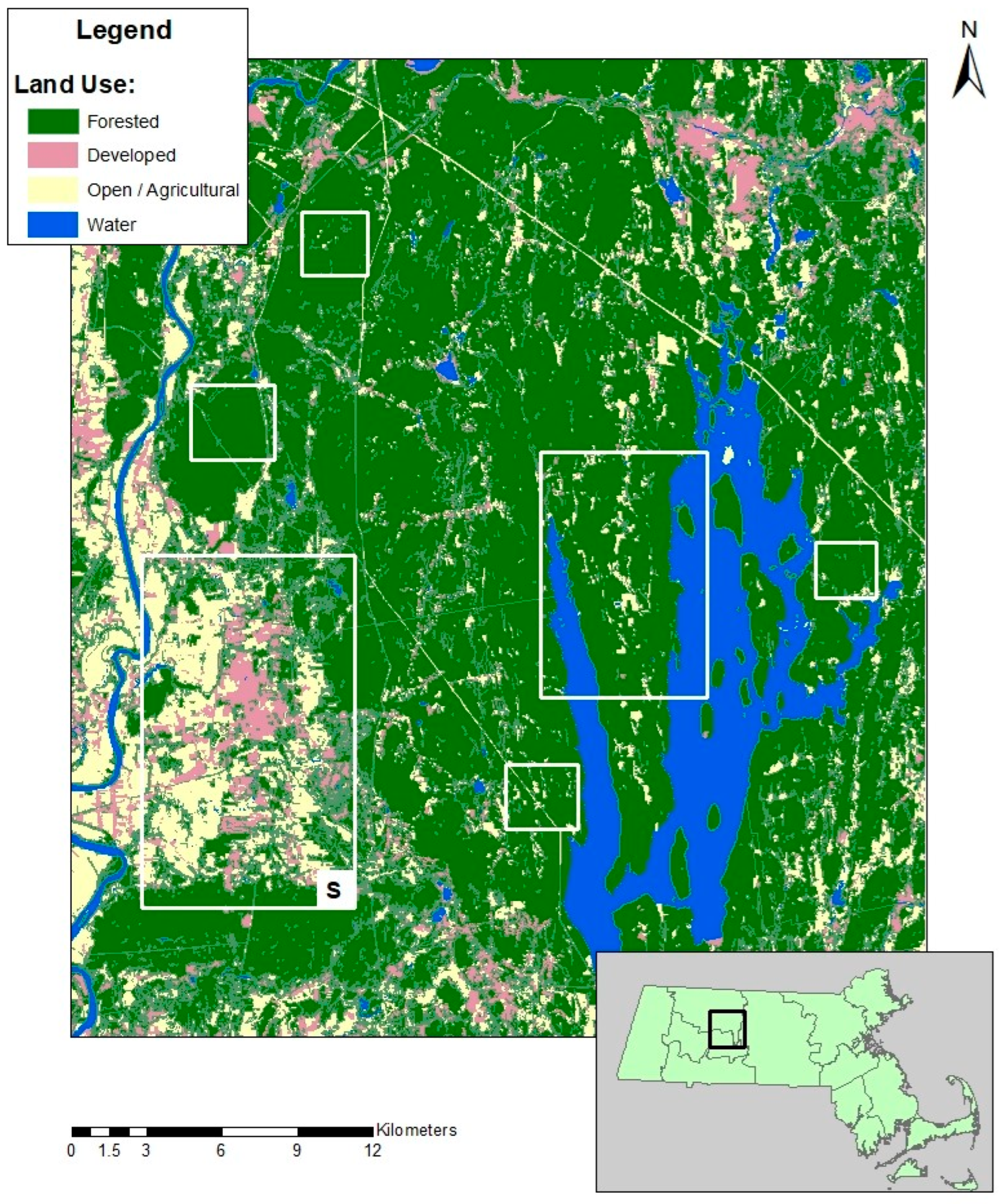
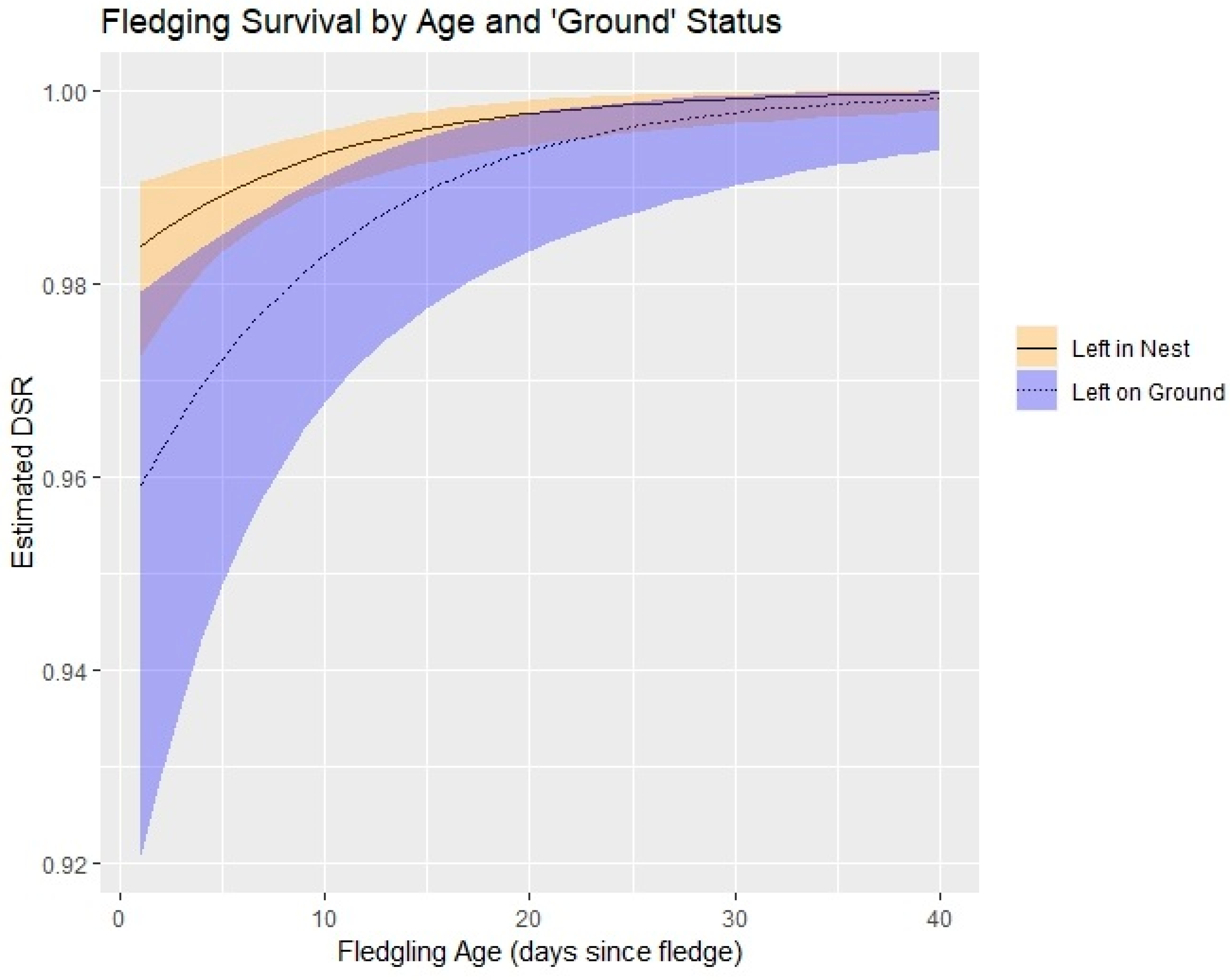
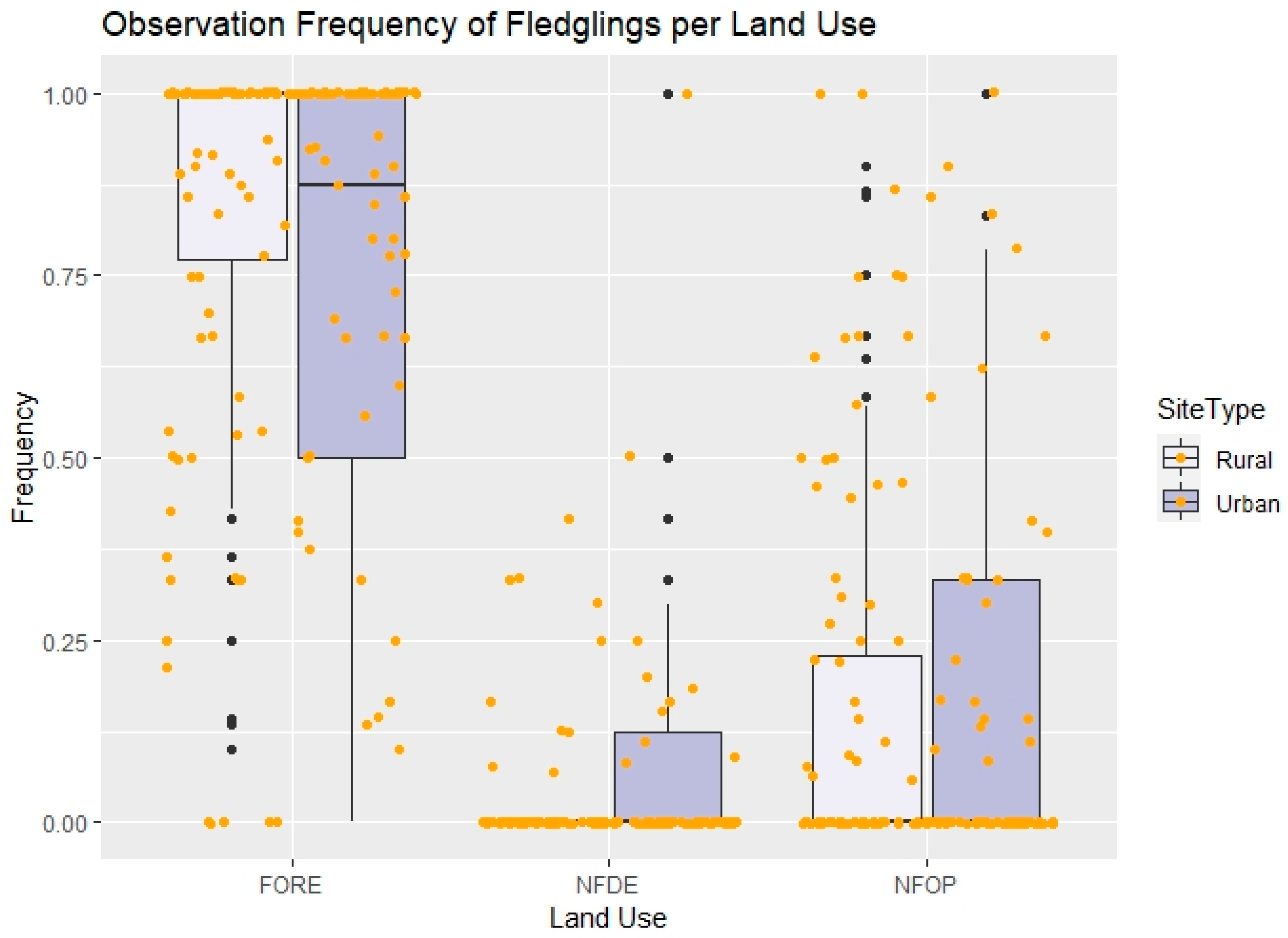
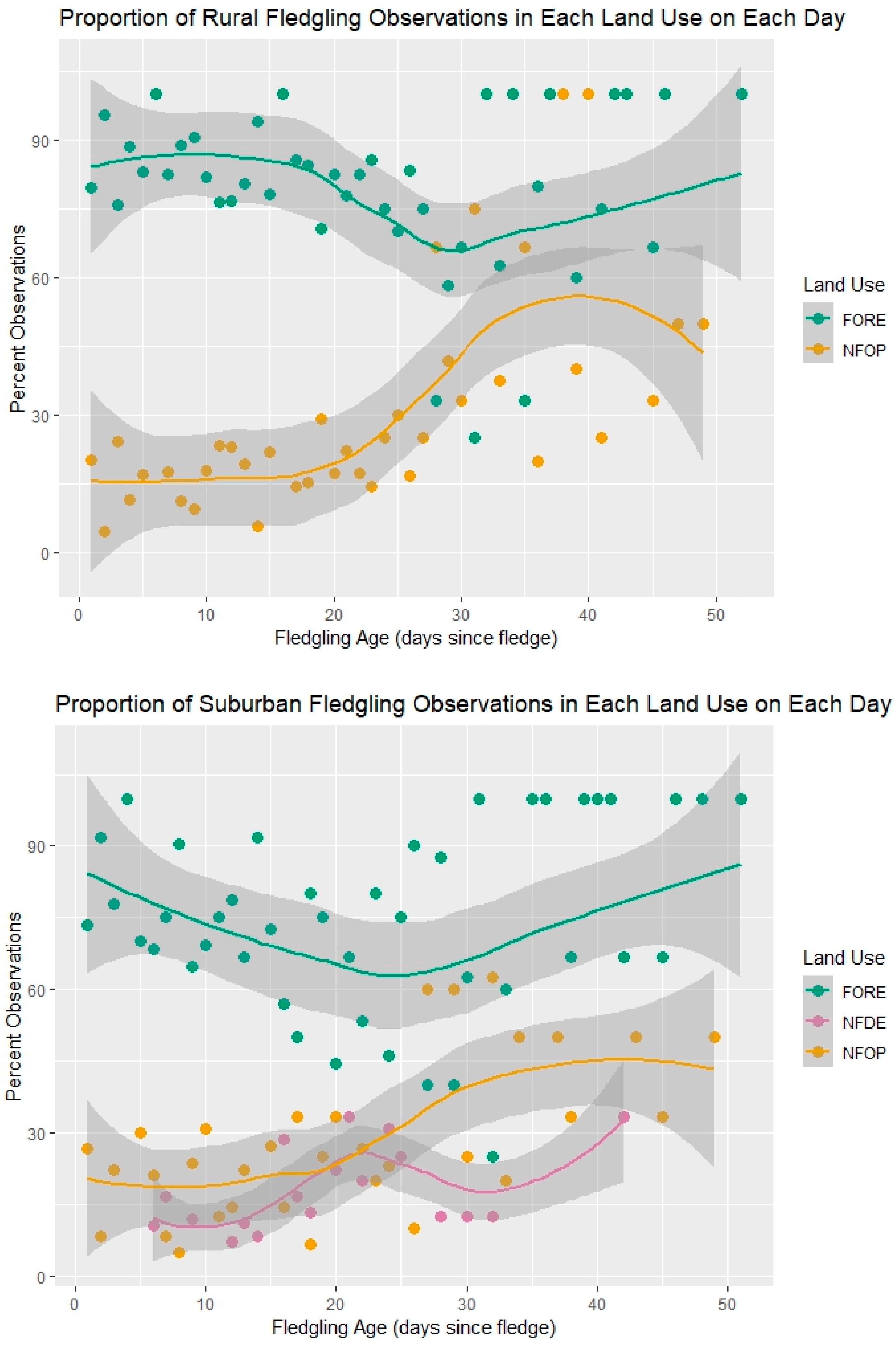
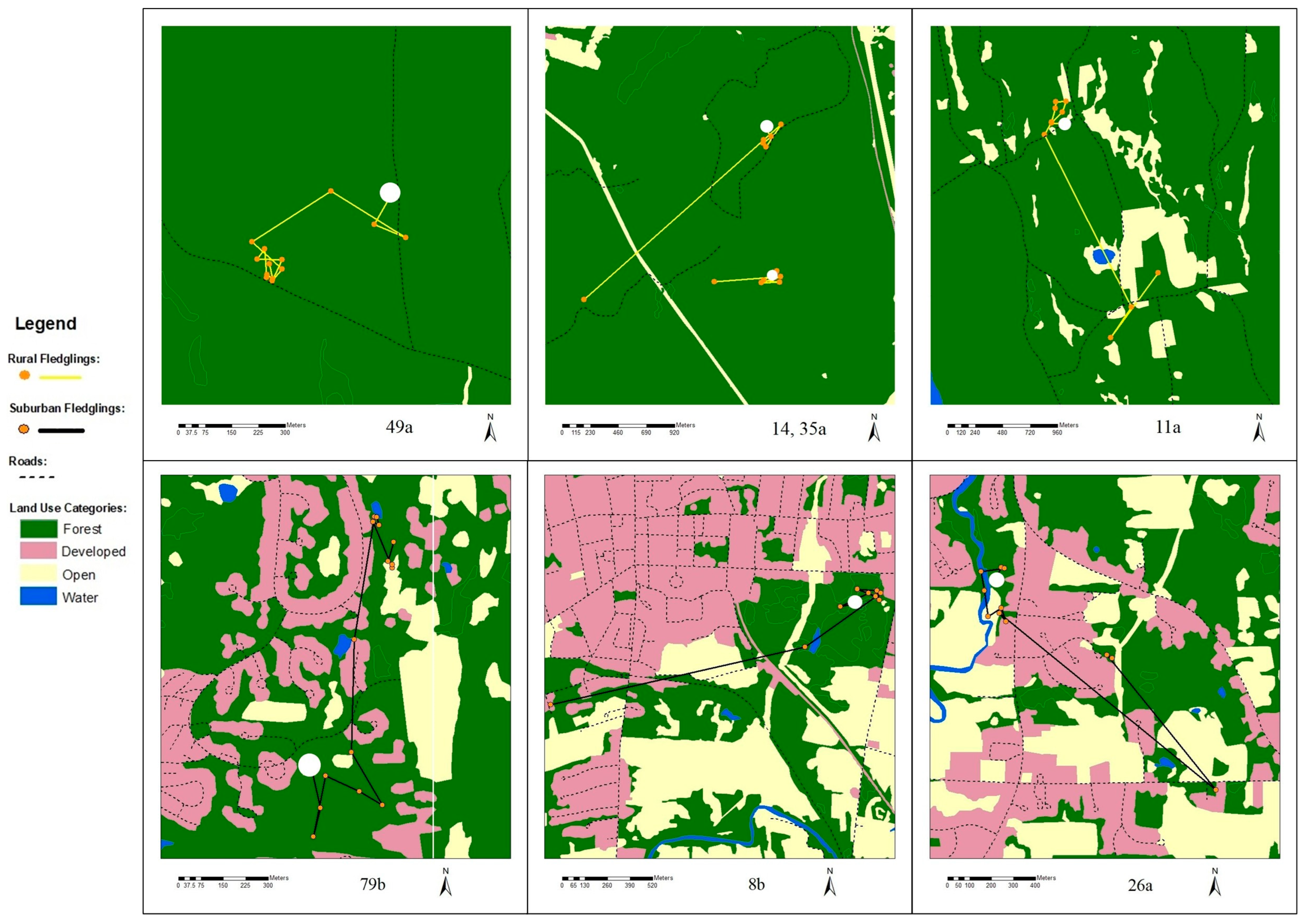
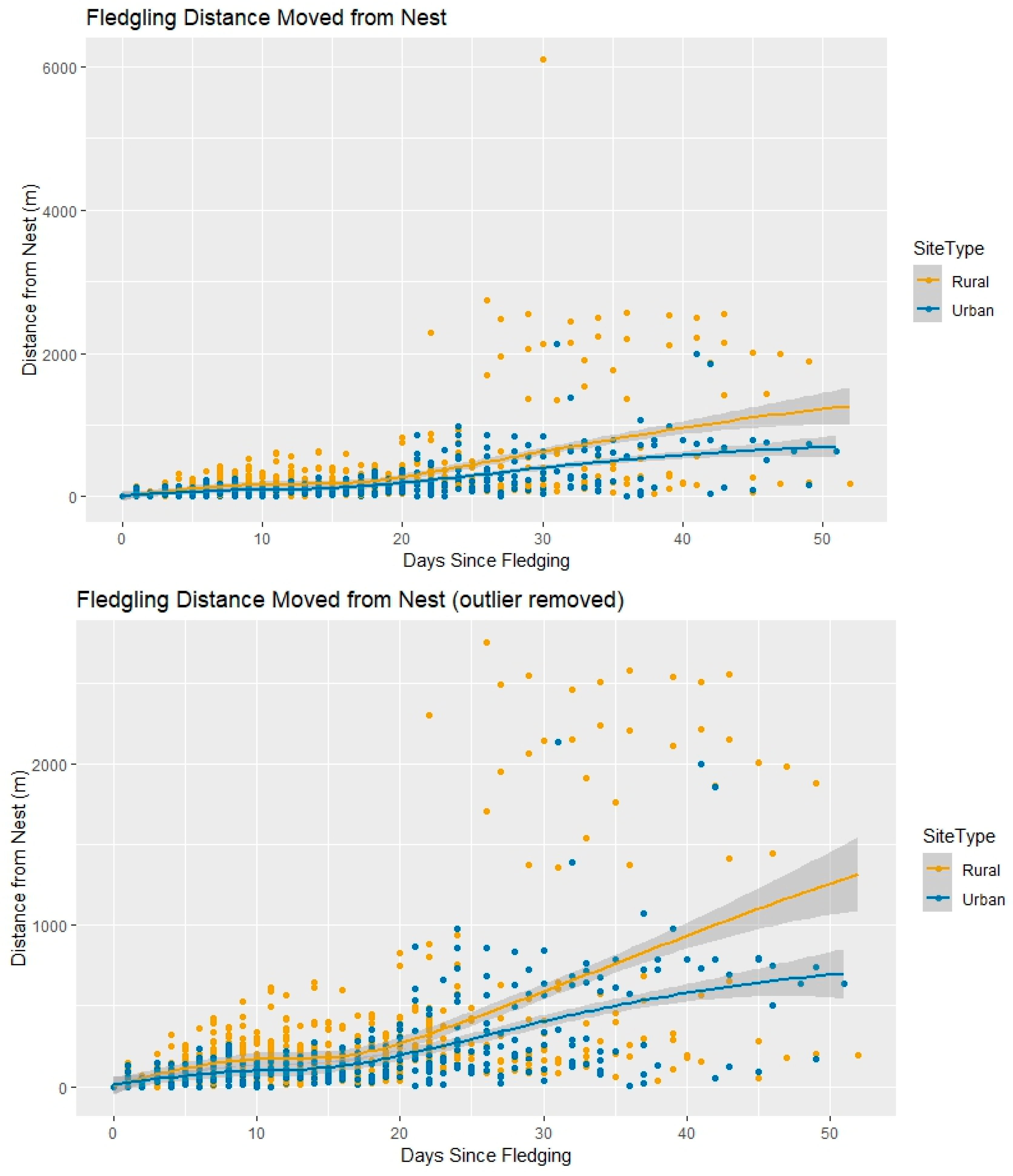
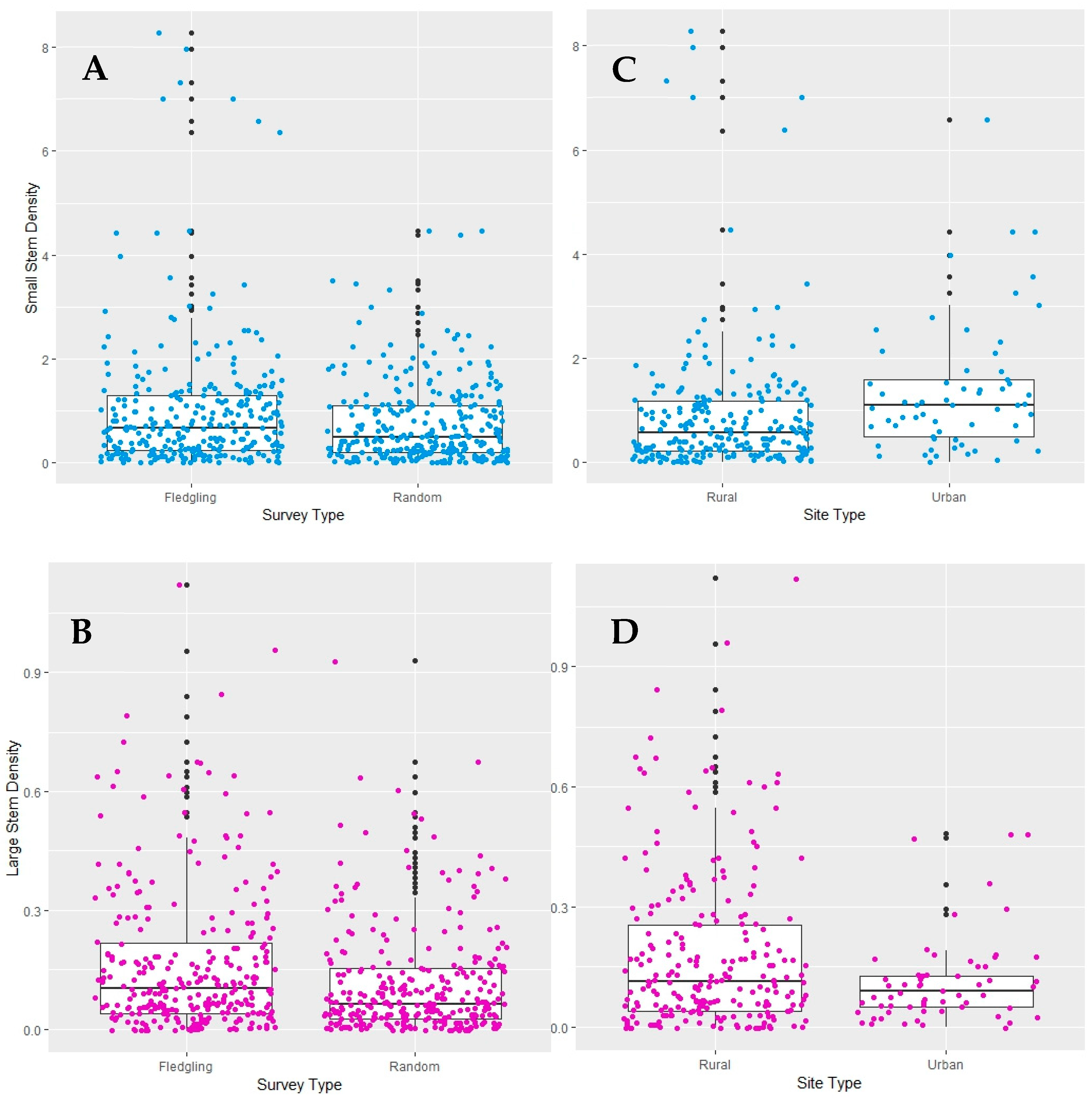
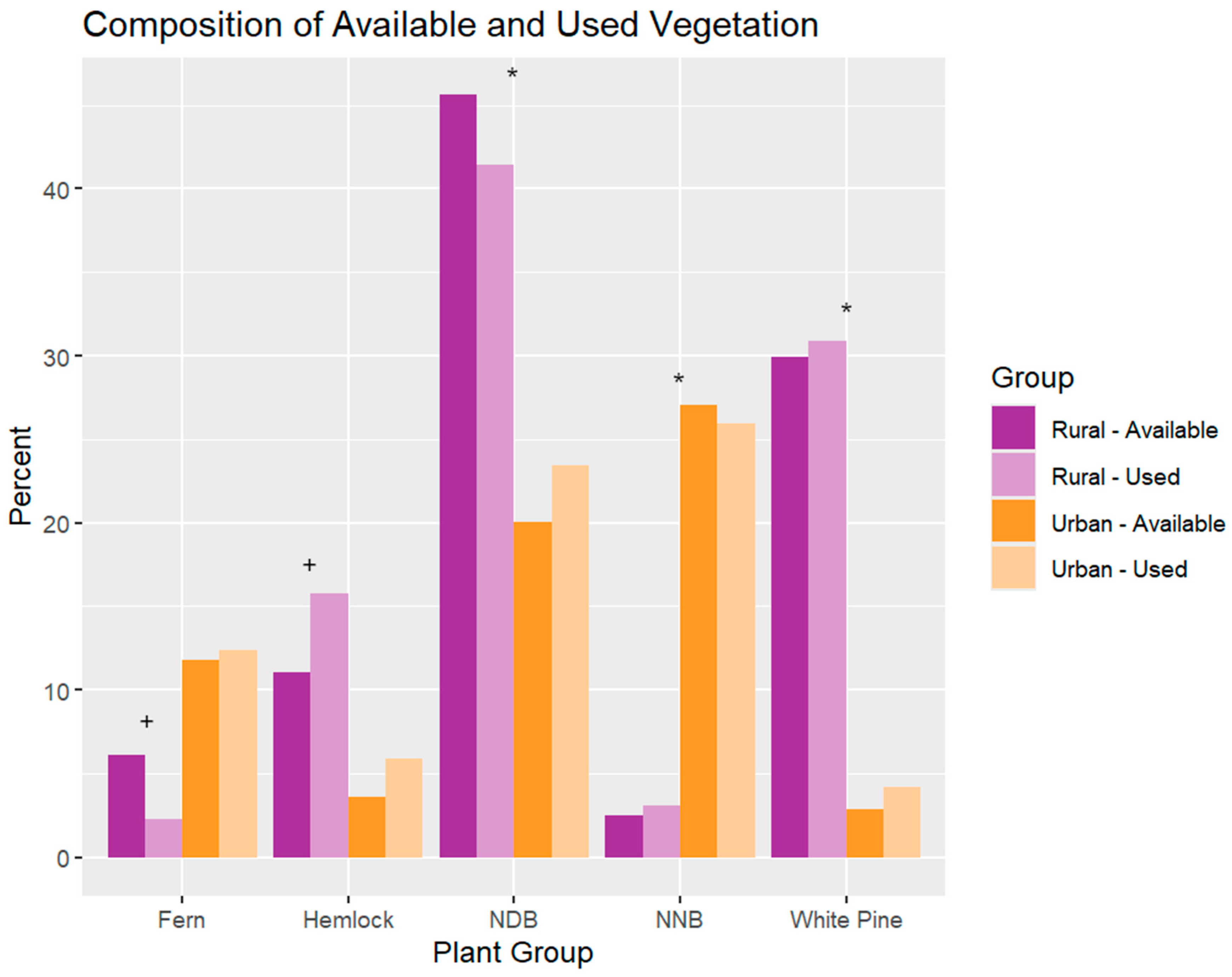
| 2011 | 2012 | 2016 | 2017 | All Years | |
|---|---|---|---|---|---|
| Total fledglings | 40 | 90 | 36 | 2 | 168 |
| Total rural fledglings | 29 | 70 | 0 | 0 | 99 |
| Total suburban fledglings | 11 | 20 | 36 | 2 | 69 |
| Total nests | 19 | 39 | 20 | 2 | 80 |
| Total rural nests | 14 | 29 | 0 | 0 | 43 |
| Mean fledglings per nest | 2.1 | 2.4 | NA | NA | 2.3 |
| Total suburban nests | 5 | 10 | 20 | 2 | 37 |
| Mean fledglings per nest | 2.2 | 2.0 | 1.8 | 1.0 | 1.9 |
| Total sites | 5 | 10 | 12 | 1 | 20 * |
| Total rural sites | 3 | 5 | 0 | 0 | 5 |
| Total suburban sites | 2 | 5 | 12 | 1 | 15 |
| Mean fledglings per site | 8 | 9 | 3 | 2 | 8.4 |
| Model | Npar | AICc | DeltaAICc | Weight | Deviance |
|---|---|---|---|---|---|
| S(~Ground × FAge) | 4 | 265.2953 | 0 | 6.70 × 10−1 | 257.2847 |
| S(~Ground + FAge) | 3 | 267.0554 | 1.760056 | 2.78 × 10−1 | 261.049 |
| S(~FAge) | 2 | 270.3881 | 5.09282 | 5.25 × 10−2 | 266.385 |
| S(~Ground) | 2 | 283.1154 | 17.8201 | 9.04 × 10−5 | 279.1122 |
| S(~Ground × SiteType) | 4 | 284.9885 | 19.69321 | 3.54 × 10−5 | 276.9779 |
| S(~1) | 1 | 287.8413 | 22.545979 | 8.51 × 10−6 | 285.8402 |
| S(~Time) | 2 | 289.2439 | 23.94856 | 4.22 × 10−6 | 285.2407 |
| S(~SiteType) | 2 | 289.8271 | 24.53175 | 3.15 × 10−6 | 285.8239 |
| S(~Year) | 4 | 293.0384 | 27.74309 | 6.33 × 10−7 | 285.027 |
| Model | Degrees of Freedom | AIC |
|---|---|---|
| Full | 6 | 14,930.03 |
| Nests | 5 | 14,949.21 |
| Birds | 5 | 14,944.38 |
| Fixed Only | 4 | 15,109.68 |
| DaysOnly | 3 | 15,163.86 |
| SiteOnly | 3 | 15,868.86 |
Disclaimer/Publisher’s Note: The statements, opinions and data contained in all publications are solely those of the individual author(s) and contributor(s) and not of MDPI and/or the editor(s). MDPI and/or the editor(s) disclaim responsibility for any injury to people or property resulting from any ideas, methods, instructions or products referred to in the content. |
© 2025 by the authors. Licensee MDPI, Basel, Switzerland. This article is an open access article distributed under the terms and conditions of the Creative Commons Attribution (CC BY) license (https://creativecommons.org/licenses/by/4.0/).
Share and Cite
Klein, M.L.; Schlossberg, S.; Warren, P.S.; Straley, K.; King, D.I. Post-Fledging Survival, Movement, and Habitat Use of Wood Thrushes in a Suburbanized Landscape. Diversity 2025, 17, 589. https://doi.org/10.3390/d17080589
Klein ML, Schlossberg S, Warren PS, Straley K, King DI. Post-Fledging Survival, Movement, and Habitat Use of Wood Thrushes in a Suburbanized Landscape. Diversity. 2025; 17(8):589. https://doi.org/10.3390/d17080589
Chicago/Turabian StyleKlein, Melanie L., Scott Schlossberg, Paige S. Warren, Katherine Straley, and David I. King. 2025. "Post-Fledging Survival, Movement, and Habitat Use of Wood Thrushes in a Suburbanized Landscape" Diversity 17, no. 8: 589. https://doi.org/10.3390/d17080589
APA StyleKlein, M. L., Schlossberg, S., Warren, P. S., Straley, K., & King, D. I. (2025). Post-Fledging Survival, Movement, and Habitat Use of Wood Thrushes in a Suburbanized Landscape. Diversity, 17(8), 589. https://doi.org/10.3390/d17080589







